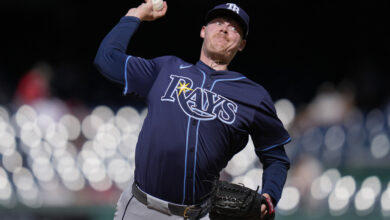
Recent Cubs Games Highlight Two Rules MLB Must Clarify
Over the course of their last three games, the Cubs have been subject to a pair of MLB’s unnecessarily subjective rules, both of which have cost them. Well, the one really didn’t cost them recently so much as it has throughout the season. And the other has been botched so many times that every team will be burned by it from time to time.
By opting for Supreme Court Justice Potter Stewart’s “I know it when I see it” standard for illegal pitching motions and checked swings, baseball is leaving open bothersome loopholes that could be closed with a few simple words. Much of the talk lately has been about Rule 5.07, which deals with a pitcher’s delivery from the mound.
Included in an exhaustive description are the following requirements:
After assuming Set Position, any natural motion associated with his delivery of the ball to the batter commits him to the pitch without alteration or interruption.
The pitcher may not take a second step toward home plate with either foot or otherwise reset his pivot foot in his delivery of the pitch. If there is a runner, or runners, on base it is a balk under Rule 6.02(a); if the bases are unoccupied it is an illegal pitch under Rule 6.02(b).
Anyone can watch Carter Capps‘ delivery and understand how it breaks both the letter and spirit of the law, even though it was actually allowed for a while.

But was Carl Edwards Jr. actually taking a second step? Not really, since you have to take a first step before you can take a second, though he had been planting his foot firmly on the ground before striding to the plate. And what about Cory Gearrin or Sean Doolittle, the latter of whom barely grazed the mound with his cleat before proceeding?
The problem with the rule as it’s written is that there exists no definitive language about the legality of a pitcher’s foot touching down. So just fix that by amending the rule to say that can’t happen. Done.
When it comes to whether or not a batter has checked his swing, however, there’s virtually no language at all. The MLB rulebook defines a swing as “an attempt to strike at the ball,” but offers zero guidelines as to what constitutes an attempt. Does the hitter have to break his wrists? Does the bat have to cross the front plane of the plate?
And while the latter seems to be a pretty easily enforceable standard, we’re still left with the question of who bears the burden for such a call. As you no doubt already know, that responsibility currently lies with whichever corner base umpire is looking “into” the hitter (1B for RHH, 3B for LHH). But those guys are more than 90 feet away and must rely purely on instinct and depth perception to make the right call.
Except that the “right” call is really just up to that particular umpire’s opinion on whether the batter attempted a swing.
On borderline checks like the one Monday night by Andrew McCutchen that would have ended the game, or the one by Kyle Schwarber that left the slugger incensed, only overhead or side views can properly discern the bat’s location relative to the plate. The call against Schwarber, which was correct, ended the game. The call for McCutchen, which was incorrect, would have ended the game.
So how about instead of the other night the Cubs play this game under protest instead pic.twitter.com/uOMskLPYL7
— FullCountTommy (@FullCountTommy) May 21, 2019
Don’t get it twisted, I’m not putting the Cubs’ loss on an umpire’s judgement call. I mean, I sort of am, since having to get a fourth out was too much for them in the end. But going beyond just one call and one game — in which the offense failed to capitalize on ample opportunities — I’m simply saying that no outcome should ever hang in the balance of an umpire’s judgement call. So how do we fix this?
Because adjudicating every checked swing with a replay review is tedious and would cause Commissioner Rob Manfred to dislike the game more than he already does, I propose creating a set standard and enacting a replay on checked third strikes. If the bat breaks the front of the plate, it’s a swing. The umps don’t even need to huddle, just have the eye in the sky at MLB HQ buzz the home plate up if the guy went.
Or hell, get Roy Munson’s Bowling Supply Emporium to equip each plate with a laser system like they’ve got on the lanes at your local bowl-o-rama. Turn it on with two strikes and, voila! A red light goes on somewhere and everyone knows it was a strike. And without an actual human making the call, some of the inevitable grousing that comes from these situations is eliminated.
So there, I have fixed two of MLB’s problems and will be sending an invoice to the league offices seeking payment for my 5 minutes of billable time.

